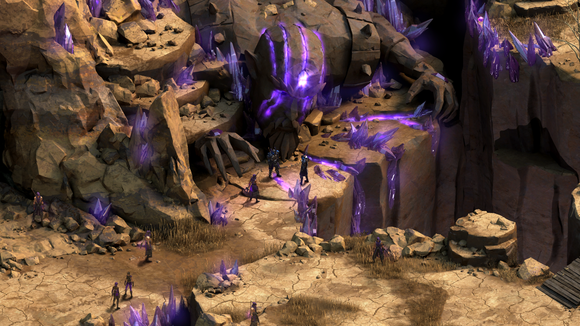
Last week Obsidian dangled the smallest scraps of a new project: Tyranny, a new isometric CRPG built in the Pillars of Eternity engine. A world where the battle between good and evil already took place, and evil won.
Here’s the trailer again, in case you need a refresher:
Pretty light on the details, eh? Luckily we got a half-hour demo of the project at GDC. The key takeaway: Tyranny might share the same engine as Pillars of Eternity, but that’s about all. This is a wild project.
You’re going to miss it all
Pillars of Eternity was built in the vein of the old Infinity Engine games—Baldur’s Gate and its sequel, Planescape Torment, Icewind Dale, et cetera. Loooooooooong RPGs, with some amount of player freedom within the confines of a fairly rigid plot.
Tyranny is not that. Talking to Obsidian, it sounds like Tyranny is actually more like…Alpha Protocol? Yes, the flawed-but-sort-of-brilliant third-person shooter Obsidian released in 2010. Bet you didn’t expect that to be relevant to an isometric CRPG.
Alpha Protocol was a bold experiment in branching storylines, though. Small details, changed by an errant word here, an incidental choice there. It’s this spirit which makes its way into Tyranny. Our demo focused on one little area: The village of Plainsgate. Or is it Halfgate?
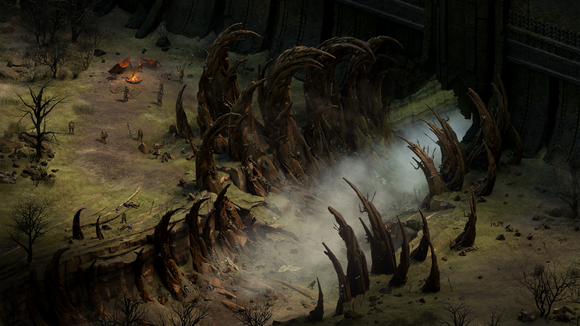
As with most RPGs, the first thing you do in Tyranny is create your character. This isn’t some farmer-in-rags though, or an escaped prisoner. In Tyranny, you play as a “Fatebinder,” which Obsidian’s Brian Heins described to us as “kind of like Judge Dredd.” Said Heins, “You get to bring your brand of justice to the people you meet and you have the full weight of armies backing that authority. People don’t mess with you unless they think they can stand against you.”
But as part of creating your Fatebinder, you’re asked to make certain decisions which set the state of the world—events that occurred during the aforementioned war between good and evil. Thus the Plainsgate/Halfgate conundrum.
We played the same small section of the game through twice. In one, the village of Plainsgate was occupied by foreign armies, dusty but resplendent with its Bronze Age architecture. The various crises central to Tyranny’s plot had taken a toll on Plainsgate, but it looked like a pleasant-enough place. Your typical Infinity Engine city, really.
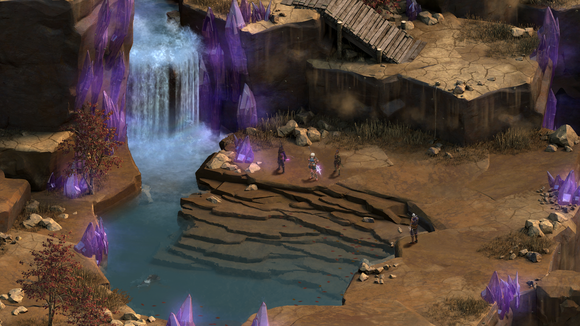
Flip to a different saved state, and Plainsgate became a very different place. It was the same town except, oh yeah, a massive chasm ran through the middle of the town and took half the buildings with it. Halfgate.
Again, according to Obsidian this is because of a choice made during character creation. Literally half of the town, and presumably some of the game’s quests, were removed.
Now, maybe Obsidian simply showed us the biggest, flashiest example in the game and everything else will pale in comparison. But Plainsgate/Halfgate is already more reactive than anything in Pillars of Eternity, and it seems like modularity is key to the whole experience here.
Factions, for instance. Factions in Pillars of Eternity don’t really do much. Being aligned with the Crucible Knights or The Dozens can be advantageous for certain quests, but doesn’t really change the way you play.
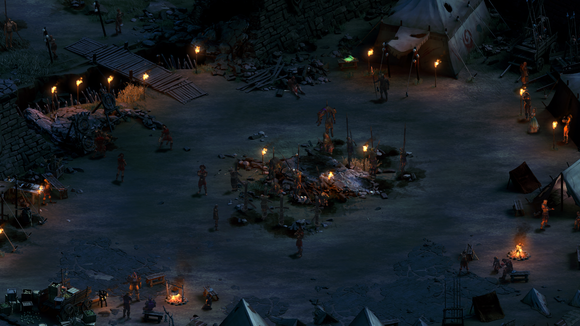
“Reputation in Tyranny is not just about whether a faction likes or hates you,” says Heins. “It also changes what abilities you have as a character. Sometimes, choosing to piss someone off will work out better for you in the long run than keeping them as a friend.”
This dovetails with Tyranny’s classless leveling system—more commonly known as “That system in the Elder Scrolls games.” Use a skill—be it sword fighting or talking to others or what have you—and you get better in it.
Every system demoed to us seemed designed for a game you replay—not just once but multiple times. And if this were a Pillars-sized, forty-to-sixty hour RPG I’d say that was crazy. Who has time for that?
But it’s not. Breaking with tradition once more, Obsidian says Tyranny is probably somewhere under or around twenty hours. In other words: It’s Alpha Protocol sized. Something you’re actually likely to replay.
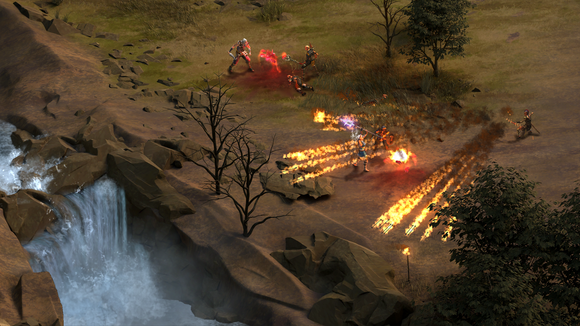
Listen, I loved Pillars of Eternity. I had a great time with it, and it brought back fond memories of playing Baldur’s Gate fifteen years prior. Hell, it made its way onto our Game of the Year list for 2015.
Tyranny seems a great deal more experimental though, and it has me fascinated. Now that we’ve played the obligatory Infinity Engine throwback game, I’m excited to see Obsidian using its isometric tech for something wholly unique. Something that’s not constrained by prior notions about “what the interface should look like” or “what arc the player should follow.”
Oh, and I’m totally opting for Halfgate. Sure, I might miss out on some quests, but the village is amazing with a hole ripped through the center. Look for Tyranny at the end of 2016—barring the usual Obsidian delays, of course.
[“source-gsmarena”]